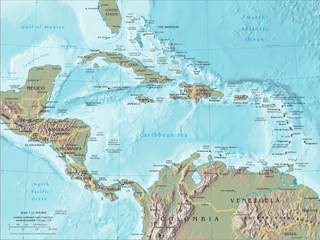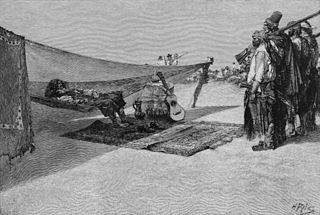Related Research Articles

Buccaneers were a kind of privateer or free sailors particular to the Caribbean Sea during the 17th and 18th centuries. First established on northern Hispaniola as early as 1625, their heyday was from the Restoration in 1660 until about 1688, during a time when governments in the Caribbean area were not strong enough to suppress them.

Sir Henry Morgan was a Welsh privateer, plantation owner, and, later, Lieutenant Governor of Jamaica. From his base in Port Royal, Jamaica, he and those under his command raided settlements and shipping ports on the Spanish Main, becoming wealthy as they did so. With the prize money and loot from the raids, Morgan purchased three large sugar plantations on Jamaica.

The era of piracy in the Caribbean began in the 1500s and phased out in the 1830s after the navies of the nations of Western Europe and North America with colonies in the Caribbean began hunting and prosecuting pirates. The period during which pirates were most successful was from the 1660s to the 1730s. Piracy flourished in the Caribbean because of the existence of pirate seaports such as Port Royal in Jamaica, Tortuga in Haiti, and Nassau in the Bahamas. Piracy in the Caribbean was part of a larger historical phenomenon of piracy, as it existed close to major trade and exploration routes in almost all the five oceans.

Pirate havens are ports or harbors that are a safe place for pirates to repair their vessels, resupply, recruit, spend their plunder, avoid capture, and/or lie in wait for merchant ships to pass by. The areas have governments that are unable or unwilling to enforce maritime laws. This creates favorable conditions for piracy. Pirate havens were places where pirates could find shelter, protection, support, and trade.

Tortuga Island is a Caribbean island that forms part of Haiti, off the northwest coast of Hispaniola. It constitutes the commune of Île de la Tortue in the Port-de-Paix arrondissement of the Nord-Ouest department of Haiti.

Thomas Tew, also known as the Rhode Island Pirate, was a 17th-century English privateer-turned-pirate. He embarked on two major pirate voyages and met a bloody death on the second, and he pioneered the route which became known as the Pirate Round. Other infamous pirates in his path included Henry Avery and William Kidd.
Benjamin Fletcher was colonial governor of New York from 1692 to 1697. Fletcher was known for the Ministry Act of 1693, which secured the place of Anglicans as the official religion in New York. He also built the first Trinity Church in 1698.

The Golden Age of Piracy is a common designation for the period between the 1650s and the 1730s, when maritime piracy was a significant factor in the histories of the North Atlantic and Indian Oceans.

Roche Braziliano was a Dutch Brazilian pirate born in the town of Groningen. His pirate career lasted from 1654 until his disappearance around 1671. He was first made famous in Alexandre Exquemelin's 1678 book The Buccaneers of America; Exquemelin did not know Braziliano's real name, but historians have found he was probably born as Gerrit Gerritszoon and that he and his parents moved to Dutch-controlled Brazil. He is known as "Roche Braziliano", which in English translates to "Rock the Brazilian", due to his long exile in Brazil.

The Brethren or Brethren of the Coast were a loose coalition of pirates and buccaneers that were active in the seventeenth and eighteenth centuries in the Atlantic Ocean, Caribbean Sea, and Gulf of Mexico. They mostly operated in two locations, the island of Tortuga off the coast of Haiti and in the city of Port Royal on the island of Jamaica.
This timeline of the history of piracy in the 1640s is a chronological list of key events involving pirates between 1640 and 1649.
This timeline of the history of piracy in the 1670s is a chronological list of key events involving pirates between 1670 and 1679.
Laurens Prins, anglicized as Lawrence Prince, was a 17th-century Dutch buccaneer, privateer and an officer under Captain Sir Henry Morgan. He and Major John Morris led one of the columns that raided Panama in 1671.

Daniel Montbars (1645–1707?), better known as Montbars the Exterminator, was a 17th-century French buccaneer. For several years, he was known as one of the most violent buccaneers active against the Spanish during the mid-17th century. His reputation as a fierce enemy of the Spanish Empire was matched only by François l'Olonnais and Roche Braziliano.

Edward Mansvelt or Mansfield was a 17th-century Dutch corsair and buccaneer who, at one time, was acknowledged as an informal chieftain of the "Brethren of the Coast". He was the first to organise large scale raids against Spanish settlements, tactics which would be utilised to attack Spanish strongholds by later buccaneers in future years, and held considerable influence in Tortuga and Port Royal. He was widely considered one of the finest buccaneers of his day and, following his death, his position was assumed by his protégé and vice-admiral, Henry Morgan.
Claes Gerritszoon Compaen, also called Claas Compaan or Klaas Kompaan, was a 17th-century Dutch corsair and merchant. Dissatisfied as a privateer for the Dutch Republic, he turned to piracy and captured hundreds of ships operating in Europe, the Mediterranean and West Africa during the 1620s.
Jan Erasmus Reyning (1640–1697) was a Dutch pirate, privateer and naval officer.

The Salé Rovers, also known as the Sallee Rovers, were a group of Barbary pirates active during the 17th and 18th centuries in the Mediterranean Sea and Atlantic Ocean. Like other Barbary pirates, they attacked Christian merchant shipping and ransomed or enslaved any crew members and passengers they captured. Numerous Salé Rovers operated out of the Republic of Salé, which was established on the mouth of the Bou Regreg river and existed from 1627 to 1668. Many of the corsairs of the Salé Rovers were of European descent, most whom were English and Dutch Protestants. One such corsair was the Dutchman Jan Janszoon, who converted to Islam after being captured by Barbary pirates in 1618 and was renamed Murat Reis. By the 18th century, anti-piracy operations by European navies such as the British Royal Navy led to the eventual decline and disappearance of the Salé Rovers.
References
- ↑ Snelders, Stephen. The Devil's Anarchy. New York: Autonomedia, 2005. (pg. 84) ISBN 1-57027-161-5
- ↑ Konstam, Angus. Pirates: Predators of the Seas. New York: Skyhorse Publishing, 2007. (pg. 105) ISBN 1-60239-035-5
- ↑ Herman, Arthur. To Rule the Waves: How the British Navy Sharped the Modern World. New York: HarperCollins Publishers, 2004. (pg. 172) ISBN 0-06-053424-9
- ↑ Snelders, Stephen. The Devil's Anarchy. New York: Autonomedia, 2005. (pg. 6) ISBN 1-57027-161-5
- ↑ Leyland, John. The Yorkshire Coast and the Cleveland Hills and Dales. London: Seeley & Company, 1892. (pg. 212-213)
- ↑ Bennett, Martyn. The Civil Wars Experienced: Britain and Ireland, 1638–1661. London: Routledge, 2000. (pg. 155) ISBN 0-415-15901-6
- ↑ Port Royal
- ↑ Keegan, John and Andrew Wheatcroft. Who's Who in Military History: From 1453 to the present. New York: Routledge, 2002. (pg. 21) ISBN 0-415-12722-X
- ↑ Harris, Graham. Treasure and Intrigue: The Legacy of Captain Kidd. Toronto: Dundurn Press, 2002. (pg. 320) ISBN 1-55002-409-4
- ↑ Wilson, J. G.; Fiske, J., eds. (1900). . Appletons' Cyclopædia of American Biography . New York: D. Appleton.
- ↑ American Council of Learned Societies. Dictionary of American Biography, Vol. 8. New York: Scribner's Sons, 1959. (pg. 140)
- ↑ McCarthy, Kevin M. Twenty Florida Pirates. Sarasota, Florida: Pineapple Press, 1994. (pg. 35) ISBN 1-56164-050-6
